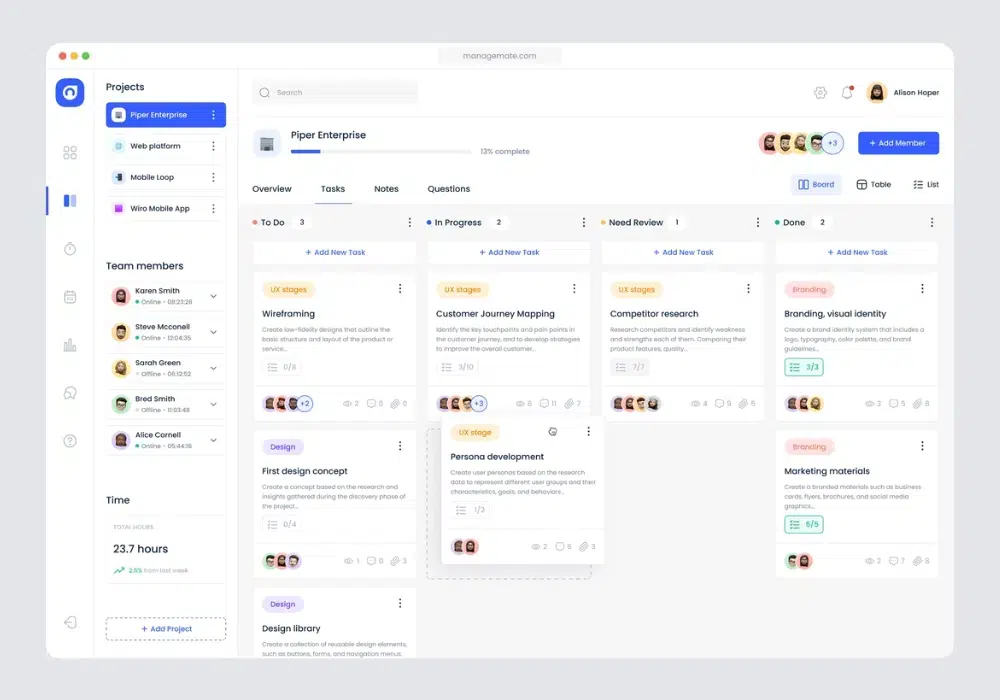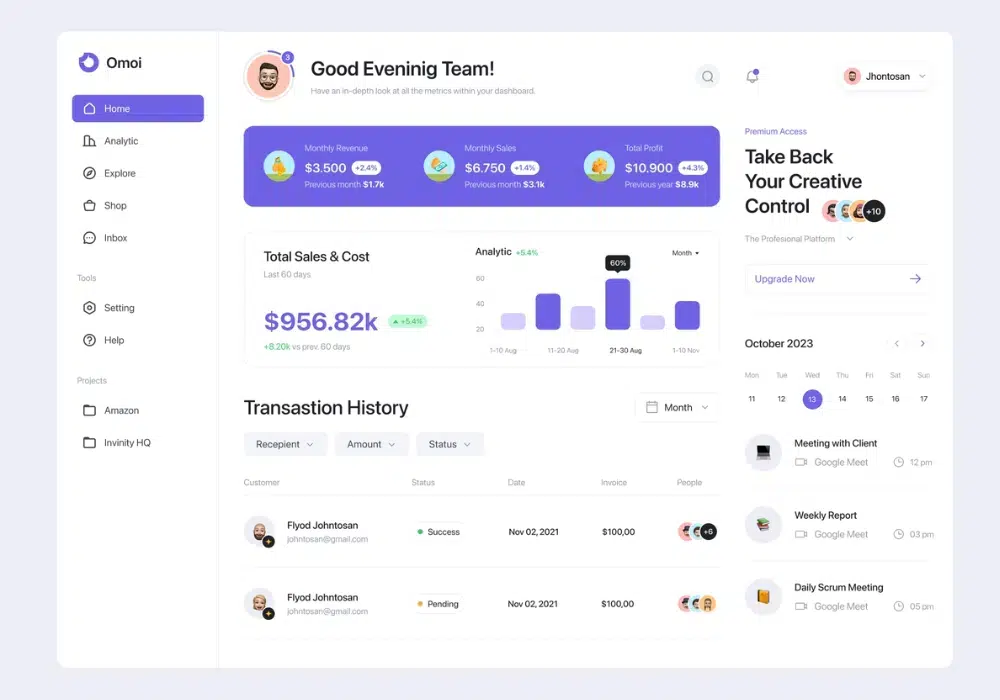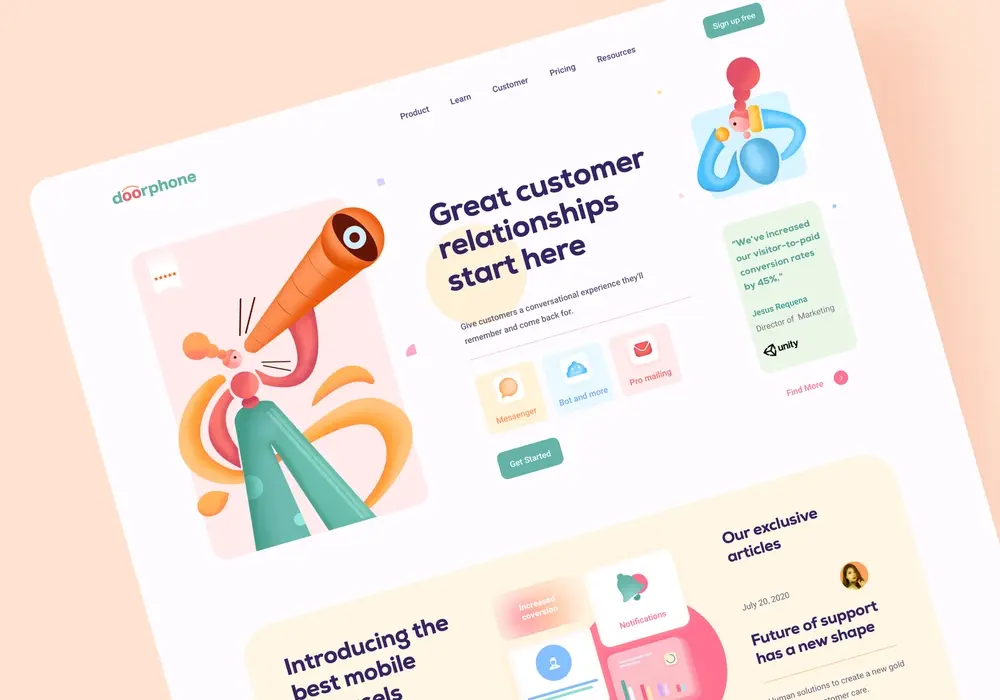Everything You Need To Know About SaaS Application Development
In recent years, Software as a Service (SaaS) has emerged as a game-changer, revolutionizing the way businesses access and utilize software applications. By offering cloud-based services that are easily accessible and scalable, SaaS has transformed traditional software development and deployment models. According to Gartner, the global SaaS market is expected to reach $170 billion by 2022, reflecting the rapid adoption of these services across various industries.
As we step into a new era, the demand for innovative SaaS applications shows no signs of slowing down. As of 2021, a survey indicated that over 70% of organizations worldwide were using at least one SaaS application, highlighting the prolific nature of this model.
SaaS app development has become a crucial aspect of the software industry, enabling businesses to streamline their operations, increase productivity, and unlock new opportunities for growth. From small startups to large enterprises, organizations of all sizes are recognizing the immense potential of SaaS in driving operational efficiency and delivering exceptional user experiences.
Join Savvycom and delve into the exciting world of SaaS app development, exploring its key benefits, challenges, and the trends shaping this dynamic landscape, including emerging software development trends. Whether you are a business owner, a software developer, or simply an enthusiast curious about the future of software solutions, understanding the nuances of SaaS app development will empower you to make informed decisions and leverage this transformative technology to its fullest potential.
1. What is SaaS app development?

SaaS app development refers to an approach to obtaining access to applications via the Internet. Unlike the traditional model, applications are stored in external cloud computing storage that is accessible via the web or an API. Web-based software, on-demand software, and hosted software are other terms for SaaS applications. Such items, whatever we call them, are stored on the servers of providers. The vendor manages software access, including security, availability, and operation. This is the main difference between developing SaaS applications and traditional ones.
Developers keep working on a SaaS product even after it has been released. Regular service updates are required to attract new consumers and compete within the market.
There are a number of SaaS solutions available, ranging from office software (Google Workspace) to workplace messengers (Slack). Moreover, companies like Box, Salesforce, and Amazon have mobile app development teams that keep their solutions updated.
2. Types of SaaS software
SaaS apps can also be classified into the following categories depending on the industry which they are developed for:
- CRM (customer relationship management): CRM systems, like Salesforce, handle customer data and operations and are perfect for B2C and B2B eCommerce enterprises.
- ERP (Enterprise Resource Planning): Businesses can pay as they go (PAYG) and customize functionality depending on current company needs with (ERP) systems provided under the SaaS business model.
- Billing and accounting: SaaS apps for billing and accounting aren’t often made for the corporate sector. Instead, they provide customizable subscription plans, allowing each business to pick the best one for them based on its size, personnel, clients, and partners.
- Project and task management: Jira, ClickUp, and Monday are just a few examples of the software-as-a-service (SaaS) project management and collaboration applications on the market.
- Communication tools: One of the most well-known communication applications created using the SaaS business model is Slack. It enables selecting a subscription plan based on the size of the team and switching to a more sophisticated one as the team grows.
3. Step-by-step to build a SaaS platform

How do you start building a whole SaaS application? We’ve identified the 8 steps to creating a SaaS app development project:
- Determine the value that your app provides to users.
- Conduct market research to understand your target audience better.
- Find experienced mobile app development companies to help you turn your SaaS concept into a reality.
- Assemble project specifications to define the scope of your application.
- Pay great attention to your app’s UI/UX design.
- Create a pricing strategy in line with your value proposition.
- To maximize product quality, consider elements such as scalability and security during the SaaS app development process.
- Development and testing.
- Deploy and maintain the product.
Next, we will look at each step in more detail.
Step 1. Consider the value your app will bring
-
To gain customers for your SaaS product, providing a valuable and reliable solution is crucial. Customers want to understand its value before subscribing and paying for your product.
One way to demonstrate the value of your product is by offering a free trial for a specific period. This way, customers can appreciate the benefits and effectiveness of your SaaS service. Another option is to offer a pay-as-you-go model for users who don’t require the service frequently.
To ensure the effectiveness of these strategies, it’s recommended that you answer the following questions:
- Will your product be compatible with your company’s goals and objectives?
- Do you already have the required experts and resources, or will you hire a mobile app development team for your SaaS app development?
- How does this project fit in with your company’s other initiatives?
- How much will the project cost? What is the best app development cost and SaaS pricing strategy?
Step 2. Run market research and study your competitors
When developing SaaS software, you must first understand the market and your target audience. Researching competitors, their solutions, business models, and so on is helpful.
After analyzing the market, you will understand how to differentiate your SaaS service from the competition. Insights gained from this research can guide your SaaS app development approach.
Step 3. Find a reliable tech partner
During the next stages, you should look for and work with a reliable technology vendor. It is critical to complete the SaaS deployment with an experienced IT partner, as you will be able to entrust the technical side of the SaaS app development project to a team of competent experts. Here is some advice on how to make an informed choice and what to look for:
- The company’s knowledge and experience. Investigate the tech vendor’s experience in your industry, the technology it employs, and the services it offers.
- Portfolios and case studies. Examine the provider’s portfolio and case studies of previous projects. This will assist you in determining the company’s level of expertise and background.
- Quality and assistance. Ascertain if the provider offers a high-quality product and is prepared to provide adequate help in any technical difficulties.
Step 4. Define project requirements
Before proceeding directly to creating a SaaS application, you have to gather your detailed project requirements as part of the SaaS app development process.
It’s necessary to create a list of features. They can vary. It’s common to divide app features into two main groups: basic and advanced. MVP or basic features stand for features that are required to satisfy the user’s needs. As for advanced features, they add some exciting functions to engage more users.
Here are some questions you should answer to execute this step:
- Who will use the solution and why?
- What problem does the software solve?
- What kind of input and output data does the project require?
- How will privacy and security be handled?
- Do you require the integration of APIs or other third-party tools?
Step 5. Work on UX/UI design

After you’ve compiled a list of essential features, it’s time to create a fantastic UI/UX design for your SaaS app development project. Users nowadays are more likely to abandon websites and apps with unappealing and illegible designs. So, to make a SaaS app profitable, it must have a user-friendly design.
Creating a design requires both time and money. Wireframes serve as the foundation for your application and must prioritize user experience.
Designers will then establish a visual style for your future app. They choose the right colors, fonts, and other graphic elements.
It’s time to start designing. All app displays and conditions are created by designers. They then create a clickable prototype. The final step in the UI/UX design process is sending the design to SaaS application developers.
Step 6. Decide on your pricing strategy
When it comes to SaaS, offering tailored subscription plans is key for a successful pricing strategy. Creating multiple options is important to cater to different user needs and preferences.
It’s also a plus if your SaaS application developer includes a few free features or offers a free trial period. Google Drive, for example, offers free 15 GB storage space. If you require extra storage, you can buy a monthly subscription.
Furthermore, SaaS app development companies provide subscriptions for different numbers of users for SaaS app development. Accounts might range from 3 to 1,000. At this point, the entrepreneur must decide on the system he or she will build, how it will stand out from competitors, who the target market is, and their pricing strategy and marketing mix. For example, they could choose from the following SaaS pricing options:
- Cost-based pricing
This is one of the most popular, particularly among startups. To earn a profit using this SaaS strategy, you sell your items for more than it costs you to produce them. To make a profit, you could, for example, add a 15-20% profit margin to the cost of building a SaaS product.
- Pricing depends on the value
You can use this pricing strategy to match the cost of your SaaS product to the benefits it offers users. Rather than only estimating prices, you should research your target market to understand their wants and needs and which features of your SaaS product they value the most.
- Pricing based on competitors
Using this pricing method, you may establish your product’s price based on your competitors’ pricing without conducting extensive market research or estimating your business expenditures.
Step 7. Choose your tech stack
Selecting technologies for your SaaS app development journey is a difficult task. You must provide the developers with the project’s needs, features, and design. They can choose the technology necessary to build a SaaS application.
To ensure the growth of your solution, it’s important to keep it up to date using tools that support its development. Additionally, choosing the right technology stack for your app is crucial.
Step 8. Develop and test
SaaS developers work on the front end and back end of your application during this stage. Simultaneously, quality assurance (QA) engineers ensure that each piece of functionality functions properly, both in isolation and as part of a larger system. Many teams will employ the Agile methodology here.
SaaS developers do not create the whole application at once. Rather, they begin with a minimal viable product (MVP) that comprises only the most necessary elements to meet your target audience’s basic demands.
After the MVP is released, you can gather feedback and make improvements. The iterative process will be finished once most features are fully developed and meet your audience’s needs.
Step 9. Deploy and maintain
When your MVP is available for users, focus on evaluating its performance. During this step, you should collect user feedback, analyze it, identify what needs to be changed, and determine what new features your users require. Simultaneously, SaaS developers on your team can assist you in fixing existing problems and planning future features.
Savvycom – Your Trusted Tech Partner
From Tech Consulting, End-to-End Product Development to IT Outsourcing Services! Since 2009, Savvycom has been harnessing the power of Digital Technologies that support business’ growth across the variety of industries. We can help you to build high-quality software solutions and products as well as deliver a wide range of related professional services.
Savvycom is right where you need. Contact us now for further consultation:
- Phone: +84 24 3202 9222
- Hotline: +84 352 287 866 (VN)
- Email: [email protected]
What are the advantages of SaaS app development?
SaaS app development offers several benefits for businesses and users. Some key advantages include:
- Accessibility: SaaS applications can be accessed from anywhere with an internet connection, allowing users to work remotely and collaborate seamlessly.
- Scalability: SaaS apps can easily scale up or down based on user demand. Businesses can add or remove users and adjust resources as needed, ensuring optimal performance and cost efficiency.
- Cost-effectiveness: SaaS eliminates the need for upfront infrastructure investments and software licenses. Instead, users pay a subscription fee, reducing upfront costs and providing predictable pricing models.
- Updates and Maintenance: SaaS providers handle application updates, patches, and maintenance, relieving users of the burden of managing software updates and ensuring they always have access to the latest features and security enhancements.
- Integration: SaaS apps can often integrate with other software systems, such as CRMs, ERPs, and productivity tools, allowing for seamless data exchange and improved workflows.
What are the challenges in SaaS app development?
While SaaS app development offers numerous advantages, there are also some challenges to consider:
- Data Security: Protecting user data is crucial in SaaS app development. Providers must implement robust security measures to safeguard sensitive information and comply with data protection regulations.
- Performance and Reliability: SaaS applications must deliver consistent performance and reliability, especially during peak usage periods. Providers need to ensure their infrastructure can handle high traffic and provide a seamless user experience.
- Customization Limitations: SaaS apps are typically designed to serve a broad user base, which can result in limitations on customization options. While many SaaS platforms offer configuration settings, extensive customization may require significant development effort or even necessitate a different software approach.
- Vendor Lock-in: Switching from one SaaS provider to another may involve challenges due to data migration, integration complexities, and dependencies on specific features or APIs. Businesses should carefully consider vendor lock-in risks when selecting a SaaS provider.
What are some emerging trends in SaaS app development?
Several trends are shaping the future of SaaS app development, including:
- Industry-specific solutions: SaaS providers are focusing on developing specialized solutions tailored to specific industries, addressing unique needs and compliance requirements.
- Artificial Intelligence integration: AI technologies, such as machine learning and natural language processing, are being integrated into SaaS apps to enhance automation, analytics, and personalized user experiences.
- Collaboration and communication tools: SaaS applications are evolving to facilitate seamless collaboration, real-time communication, and project management features to support remote and distributed work environments.
- Low-code and no-code platforms: The rise of low-code and no-code development platforms empowers non-technical users to create SaaS applications using visual interfaces and pre-built components, accelerating the app development process.
- Enhanced cybersecurity measures: With increasing cyber threats, SaaS providers are investing in advanced security measures, encryption, authentication, and proactive threat detection to protect user data.
How does SaaS app development differ from traditional software development?
SaaS app development differs from traditional software development in several ways:
- Deployment Model: Traditional software is typically installed and run locally on users' machines, whereas SaaS applications are hosted and delivered over the internet.
- Accessibility: SaaS apps can be accessed from any device with an internet connection and a web browser, making them more accessible than traditional software that may require specific operating systems or hardware.
- Maintenance and Updates: SaaS providers handle maintenance, updates, and bug fixes, ensuring that users always have access to the latest version of the software. In traditional software development, users often need to manually install updates or patches.
- Licensing and Pricing: Traditional software is often sold through one-time licenses, while SaaS apps are typically offered through subscription-based pricing models, allowing users to pay for what they need on a recurring basis.
- Scalability: SaaS apps can easily scale up or down based on user demand by adjusting resources in the cloud infrastructure. Traditional software may require additional hardware or infrastructure upgrades to handle increased usage.
What technologies are commonly used in SaaS app development?
SaaS app development relies on a range of technologies, including:
- Cloud Computing: SaaS apps are built and hosted in cloud environments, utilizing infrastructure-as-a-service (IaaS) or platform-as-a-service (PaaS) providers.
- Programming Languages: Common programming languages used in SaaS app development include JavaScript, Python, Java, and Ruby. The choice of language depends on factors such as the app's requirements, performance needs, and developer preferences.
- Frameworks and Libraries: Frameworks like React, Angular, and Ruby on Rails, along with libraries and tools like Node.js and Django, are commonly used in SaaS app development to streamline development processes and provide robust functionalities.
- Databases: SaaS apps often rely on databases to store and retrieve data. Popular choices include SQL databases like MySQL and PostgreSQL, as well as NoSQL databases like MongoDB and Redis.
- APIs and Integrations: SaaS apps often integrate with other systems or services using APIs (Application Programming Interfaces) to exchange data or functionality. APIs allow seamless integration with CRMs, payment gateways, social media platforms, and more.
How can businesses ensure the success of their SaaS app development project?
To ensure the success of a SaaS app development project, businesses should consider the following:
- Thorough Planning: Clearly define the goals, target audience, and desired features of the SaaS app before starting development. Conduct market research and competitor analysis to identify unique selling points and differentiators.
- User-Centric Design: Prioritize user experience (UX) and usability in the app's design. Conduct user testing and gather feedback throughout the development process to ensure the app meets user needs and expectations.
- Agile Development Methodology: Adopt an agile approach to development, breaking the project into manageable iterations or sprints. Regularly review progress, gather feedback, and make adjustments as needed.
- Robust Security Measures: Implement robust security measures to protect user data, including encryption, authentication, and access control. Conduct regular security audits and stay compliant with data protection regulations.
- Scalability and Performance Testing: Test the app's performance and scalability under different loads to ensure it can handle increased user traffic. Monitor and optimize performance to deliver a smooth user experience.
- Continuous Improvement: Plan for continuous improvement post-launch. Collect user feedback, track metrics, and iterate on the app based on user needs and market trends.
How can machine learning in healthcare apps contribute to population health management?
Machine learning algorithms can analyze population-level data, including demographic information, health records, and environmental factors, to identify health trends and risks within specific populations. Healthcare apps can leverage this analysis to develop targeted interventions, preventive strategies, and public health initiatives to improve population health outcomes and reduce healthcare disparities.


